We may earn a commission when you purchase through affiliate links. Learn more.
Built to withstand the elements, these rugged waterproof cameras are gaining in popularity thanks to their ability to take great photos in places that bigger DSLR and mirrorless cameras can’t go without expensive underwater enclosures. To help you choose the waterproof camera that will be right for you, we’ve selected some of the best rated and full-featured models on the market in 2019 along with the important specs like shock resistance, lcd screen size, megapixels, and the maximum depth you can take the camera to underwater.
Every camera on this underwater camera list is capable of video recording, often in 1080p Full HD, and many come in various colors. While black or silver is always a classic look for cameras, if you’re planning on taking your waterproof camera under the waves or out on an adventure, consider a bright color that will stand out if you happen to drop it. Because these cameras are all built to be rugged, you’ll be able to spend more time enjoying yourself and less about keeping your camera clean and dry.
If you’re planning on going boating or diving with your waterproof camera, buying a floating wrist strap like this one by Nordic Flash is a worthwhile and relatively inexpensive purchase that can prevent your camera from sinking to the bottom if you accidentally drop it. You’ll find plenty of tips, advice, and useful information that will help you make a buying decision below the camera information.
SeaLife DC2000

While the SeaLife DC2000 is the priciest camera in this guide, it packs a huge array of professional level features into a small camera. Boasting a Sony 1 inch sensor and a maximum ISO of 25600, the image quality from the DC2000 is very impressive, with DNG RAW capture available for photographers who want to maximize image quality in post processing. Wi-Fi capability allows for wireless previewing of images and quick sharing and although GPS isn’t built into the camera, images can be geotagged with the free Link123 Plus app. The video capture specs are impressive, with the DC2000 able to capture Full 1080p HD video at 60fps. Additionally, the camera can be used to create time lapse video sequences and even GIF images. The SeaLife DC2000 is waterproof to 60 feet, and when used within the included housing, it can be taken to a depth of 200 feet, making it a serious contender for advanced divers. While most waterproof compact cameras are designed to be standalone cameras, the DC2000 can utilize several SeaLife accessories like a Fisheye Wide Angle Lens and external strobes.
Resolution: 20 Megapixels
Maximum Waterproof Depth: 60m / 200ft with housing; 18m / 60ft with inner camera
Shockproof: 1m / 3ft
Screen Size: 3″
RAW Support: Yes
GPS: No
WiFi: Yes
Olympus Stylus Tough TG‑5
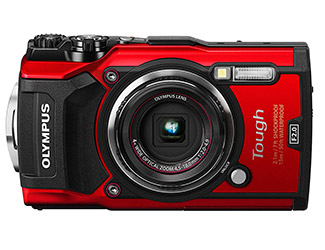 Waterproof to 50 feet, shockproof from 7 feet, and freezeproof to 14° F the 12 megapixel Olympus Tough TG-5 offers several impressive features. Perhaps most notable to advanced photographers is the inclusion of RAW image capture, which allows for greater flexibility when processing images. The f/2.0-4.9 lens provides an equivalent focal length of 25-100mm and the TG-5 offers sensor-shift image stabilization. Your location can be tracked with a built in GPS and electronic compass and the camera can even tell you useful information like the air pressure, altitude, and depth. For quick action sequences, the TG-5 can even capture RAW bursts at up to 20 frames per second. Built in Wi-Fi connectivity enables images to be easily transferred to smartphones and tablets. The TG-5 can also be used with accessories like a fisheye converter for shooting ultra-wide angle photos and a tele-converter for a longer zoom reach. For video enthusiasts, the TG-5 can also capture in 4K resolution and full HD resolution at 120fps, great for slow-motion sequences.
Waterproof to 50 feet, shockproof from 7 feet, and freezeproof to 14° F the 12 megapixel Olympus Tough TG-5 offers several impressive features. Perhaps most notable to advanced photographers is the inclusion of RAW image capture, which allows for greater flexibility when processing images. The f/2.0-4.9 lens provides an equivalent focal length of 25-100mm and the TG-5 offers sensor-shift image stabilization. Your location can be tracked with a built in GPS and electronic compass and the camera can even tell you useful information like the air pressure, altitude, and depth. For quick action sequences, the TG-5 can even capture RAW bursts at up to 20 frames per second. Built in Wi-Fi connectivity enables images to be easily transferred to smartphones and tablets. The TG-5 can also be used with accessories like a fisheye converter for shooting ultra-wide angle photos and a tele-converter for a longer zoom reach. For video enthusiasts, the TG-5 can also capture in 4K resolution and full HD resolution at 120fps, great for slow-motion sequences.
Resolution: 12 Megapixels
Maximum Waterproof Depth: 15m / 50ft
Shockproof: 2.1m / 7ft
Screen Size: 3″
RAW Support: Yes
GPS: Yes
WiFi: Yes
Nikon COOLPIX AW-130
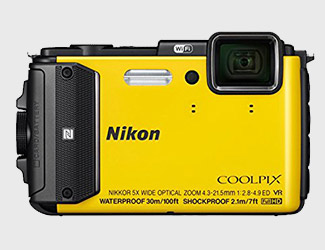 The 16 megapixel Nikon Coolpix AW130 is built to be waterproof to 100 feet, shockproof from up to than seven feet, and capable of functioning in freezing temperatures of as low as 14° F. The AW130 features built in WiFi that makes it easy to instantly send your photos to compatible smartphones, tablets, and WiFi devices. The Coolpix AW130 features hybrid vibration reduction which can help keep photos and video sharp, even in lower lighting condition. The AW130 also has a built in GPS so that you can keep a record of where your photos were taken, as well as mapping and an electronic compass.
The 16 megapixel Nikon Coolpix AW130 is built to be waterproof to 100 feet, shockproof from up to than seven feet, and capable of functioning in freezing temperatures of as low as 14° F. The AW130 features built in WiFi that makes it easy to instantly send your photos to compatible smartphones, tablets, and WiFi devices. The Coolpix AW130 features hybrid vibration reduction which can help keep photos and video sharp, even in lower lighting condition. The AW130 also has a built in GPS so that you can keep a record of where your photos were taken, as well as mapping and an electronic compass.
Resolution: 16 Megapixels
Maximum Waterproof Depth: 30.4m / 100ft
Shockproof: 2.1m / 7ft
Screen Size: 3″
RAW Support: No
GPS: Yes
WiFi: Yes
Panasonic Lumix DMC-TS30
 The 16.1 megapixel Panasonic Lumix DMC-TS30 is affordably priced and can capture 720p HD video. With a maximum waterproof depth of 26 feet, the TS30 is best suited for vacation goers and snorkelers who won’t be doing any deep diving but still want a rugged camera that can go underwater. The TS30 features a 25mm-100mm f/3.9-5.7 35mm equivalent lens and a built in torch light for extra illumination, an especially useful feature in low light when video recording and photographing close-up subjects. Consecutive vertical and horizontal images can be combined into a panorama and the camera can also create time lapse video clips.
The 16.1 megapixel Panasonic Lumix DMC-TS30 is affordably priced and can capture 720p HD video. With a maximum waterproof depth of 26 feet, the TS30 is best suited for vacation goers and snorkelers who won’t be doing any deep diving but still want a rugged camera that can go underwater. The TS30 features a 25mm-100mm f/3.9-5.7 35mm equivalent lens and a built in torch light for extra illumination, an especially useful feature in low light when video recording and photographing close-up subjects. Consecutive vertical and horizontal images can be combined into a panorama and the camera can also create time lapse video clips.
Resolution: 16.1 Megapixels
Maximum Waterproof Depth: 8m / 26ft
Shockproof: 1.5m / 5ft
Screen Size: 2.7″
RAW Support: No
GPS: No
WiFi: No
Fujifilm FinePix XP120
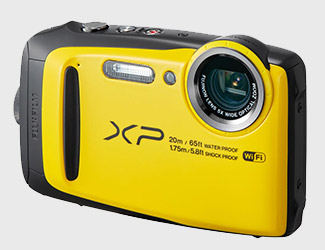 The 16.4 megapixel Fujifilm XP120 packs a number of excellent features into a compact body with a 34mm equivalent 28-140mm f/3.9-4.9 lens. Waterproof to a depth of 65 feet and shockproof from 5.8 feet, this Wi-Fi enabled camera can shoot full resolution images in a burst of ten frames per second. Full HD 1080p video can be recorded at 60 frames per second, and the camera features in-camera video editing features allowing you to cut footage and combine individual clips into a single video. Time lapse video sequences and even cinemagraphs (still photos with moving parts) can be created as well as sweeping 360° panoramic images.
The 16.4 megapixel Fujifilm XP120 packs a number of excellent features into a compact body with a 34mm equivalent 28-140mm f/3.9-4.9 lens. Waterproof to a depth of 65 feet and shockproof from 5.8 feet, this Wi-Fi enabled camera can shoot full resolution images in a burst of ten frames per second. Full HD 1080p video can be recorded at 60 frames per second, and the camera features in-camera video editing features allowing you to cut footage and combine individual clips into a single video. Time lapse video sequences and even cinemagraphs (still photos with moving parts) can be created as well as sweeping 360° panoramic images.
Resolution: 16.4 Megapixels
Maximum Waterproof Depth: 20m / 65ft
Shockproof: 1.75m / 5.8ft
Screen Size: 3″
RAW Support: No
GPS: No
WiFi: Yes
Tips for Buying a Rugged, Waterproof Compact Camera
Waterproof compact cameras are designed to be tough, making them ideal travel cameras, perfect for bringing on vacation or using around the pool or at the beach. While regular compact cameras are reasonably durable, they definitely aren’t waterproof and even things like sand, mud, and dust can get damage a typical compact camera that isn’t sealed. With numerous choices from brands like Nikon, Canon, Fujifilm, Panasonic, Olympus, and SeaLife, it’s definitely not easy to make a quick decision about which camera is right for you. To help you choose the best camera model to buy, we’ve put together some buying tips and advice, as well as a list of features that you should evaluate.
 Waterproof Compact Cameras vs Underwater Housings and Waterproof Camera Cases/Bags
Waterproof Compact Cameras vs Underwater Housings and Waterproof Camera Cases/Bags
For those who want to take pictures underwater, but haven’t yet taken the plunge, it’s often a tricky decision over whether to purchase a waterproof compact camera, or a regular camera plus a waterproof underwater housing or case.
Underwater housings are essentially protective shells that encase cameras they’re specifically designed around, and are typically made of thick plastic or aluminum, and are often capable of being submerged to depths of 30 meters or more. Like most camera accessories, underwater housings come in a variety of price points, but high-performance housings designed for advanced compact cameras, mirrorless cameras, and DSLR cameras can be quite expensive, sometimes as much as or even more than the camera they are designed to protect. For professional underwater photographers and serious enthusiasts, the ability to use their advanced camera beneath the waves, while still being able to access the important manual control buttons and dials justifies the cost.
Flexible waterproof cases like those made by Aquapac are affordable options for photographers who want waterproof protection for their cameras, but don’t need a housing that can withstand significant depth. Like underwater housings, these types of flexible cases come in a wide variety of sizes, capable of fitting different cameras.
For people who want a camera that can be used both out of the water and underwater while snorkeling and diving, waterproof compacts offer good image quality and excellent rugged durability. For a vacation ready camera, it’s tough to beat the versatility and convenient compact size of waterproof compact cameras. If you plan to travel frequently and want a camera that’s small enough to fit in your carry-on luggage, while still capable of delivering impressive image quality whether your day involves SCUBA diving, winter activities in the snow, lounging around the pool, or hiking through the rainforest, a waterproof compact is a solid choice that will leave you prepared for every kind of climate and condition.
Action Camera vs Waterproof Compact Camera
More than perhaps any other type of camera, the biggest competitor to waterproof compact cameras are action cameras like the GoPro Hero7 Black and Sony FDRX3000. If you’re searching for a camera that you can take underwater and use on land, chances are good that you’ve considered an action cam as a possibility. Action cameras bring a lot of exciting features to the table – in many newer cameras, 4K video recording and time-lapse creation are built in features.
- HyperSmooth: Get gimbal‑like stabilization—without the gimbal. HERO7 Black corrects for camera shake...
- TimeWarp: Capture super stabilized time lapse videos while you move about a scene. Increase the speed up...
- Live streaming in 720p: Share while you’re there. Live stream in 720p on social, get HyperSmooth...
- Rugged + Waterproof: Share experiences you can’t capture with your phone. HERO7 Black is rugged,...
- Ultimate image stabilization from Balanced Optical SteadyShot Professional 4K with ZEISS lens and Exmor R...
- Splash-proof body or use incl. waterproof housing down to 197ft. Selectable viewing angle: Wide, Medium...
- Interval record at 8.3MP for stills and 4K time-lapse videoHigh Quality stereo sound with wind noise...
- Intuitive interface, 3x rec. lights and adjustable beep volume;Shoot at desired angle with adjustable FOV...
If you primarily want a rugged, waterproof camera for shooting ultra-wide angle high resolution video underwater or during extreme sports, action cameras are up to the job, and they have the advantage of being very small, lightweight, and easy to mount to nearly anything. For still photography though, the optical zoom capability and easily adjustable exposure controls of waterproof compact cameras gives them an edge.
Choosing the Best Waterproof Compact Camera
Every camera user is different, which means there’s never a waterproof camera that is the “best” for everyone, but there is usually a camera that is the best for you. Figuring out which camera that is can be tricky, but you can make the decision making process much easier by making a list of how you plan to use it and what features are most important to you.
Things you might consider:
The maximum depth you plan to SCUBA dive or snorkel to with your waterproof camera
Each model of waterproof compact camera is built to withstand underwater usage to different depths. As anyone who has ever been to the bottom of a pool can attest, the deeper you go, the greater the water pressure. For most people buying a rugged compact camera, the typical underwater usage will be around the pool and while snorkeling in shallow water – tasks that every one of the cameras above can easily handle. If you plan on SCUBA diving or free diving with your waterproof camera though, you’ll want to be sure to choose a model that can be taken to the maximum depths you’d be diving to.
Whether the camera supports RAW capture
For many people who just want to capture some great snapshots while on vacation, taking JPEG images is often the easiest. Serious photography enthusiasts typically prefer to shoot RAW images though, a lossless file format that preserves more image data and requires processing using software. Some waterproof compact cameras only offer JPEG image capture, perfect for most casual users, while others offer the option of capturing photos in either JPEG or RAW formats, ideal for serious amateur photographers and professionals.
The deeper you go underwater, the less red and orange light is able to pass through the water – consequently, underwater photos tend to have a strong blue/green tint. You can learn more in this guide: Why Do Underwater Photos Look Blue and Green?
Shooting images in RAW format allows underwater photographers to easily adjust the white balance to bring out the real colors of an underwater scene.
If GPS is built in for geotagging images with location data
GPS (Global Positioning System) uses satellites in space to determine location. Cameras with built-in GPS are able to tag images with location data, a very useful feature for those who travel frequently. Rather than wondering months later where you were when you took a particular photo, GPS data allows you to know exactly where you were!
If the camera is Wi-Fi enabled for quickly transferring images to your smartphone or computer
Wi-Fi is a feature found in lots of electronic devices these days. Wi-Fi enabled compacts can make it easy to transfer images and videos wirelessly to your smartphone or computer or directly to a printer. Wireless connectivity can also allow you to control some cameras remotely via smartphone apps. Wi-Fi connectivity isn’t a feature that you’ll find on every rugged compact camera, but it is becoming more common on newer cameras.
Video recording quality and features
Virtually every digital camera these days can record video – even waterproof compact cameras. Some rugged compact cameras have more advanced video capture features than others though, with some capable of recording 720p HD video and others capable of recording higher resolution Full HD 1080p video. If still photography is your primary interest, the video features won’t be of much interest, but if you plan to take the occasional video, you’ll definitely want to compare video specs.
Choosing a Color
Black might be the typical color for most cameras, but rugged compact cameras can often be found in much brighter colors. While black is a traditional choice for cameras, if you plan on diving with your waterproof camera or taking it into challenging environments, consider a brightly colored camera, as these more vivid colors will stand out if you happen to drop it.
Using your New Waterproof Compact Camera
You might be tempted to jump right into the water as soon as your camera arrives, but you’ll want to make sure you read a few important things in your camera’s user manual first. Even though waterproof cameras are designed to work while submerged, you’ll need to always make sure that the card/battery compartment cover is always securely locked in place before using the camera in the water. After exiting the water, you should always make sure the camera is dried off before opening the battery compartment, to make sure no moisture enters the camera.
Learning About Underwater Photography
Taking pictures underwater is a lot of fun, but it is a bit different from photography on dry land! For one, things appear larger underwater than they really are, so if you’re trying to fit a large subject in the frame, you’ll need to be further from it than you would need to be on land. You can learn all about underwater photography in this guide, here on ItsJustLight:
How to Take Pictures Underwater: 10 Underwater Photography Tips

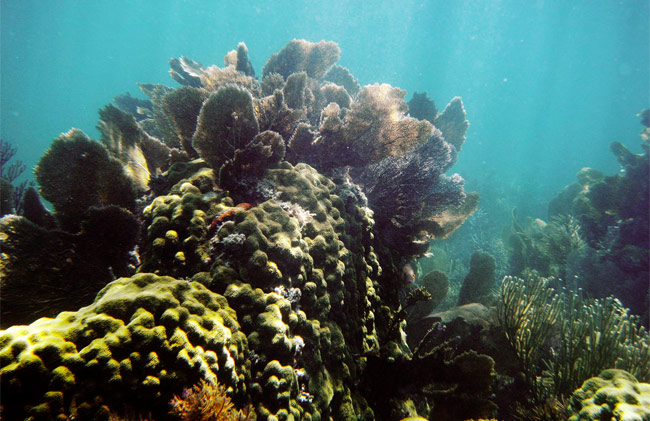
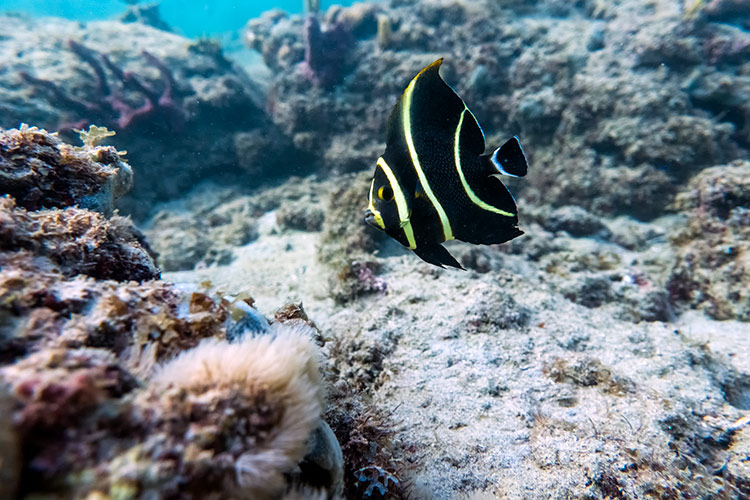 Waterproof Compact Cameras vs Underwater Housings and Waterproof Camera Cases/Bags
Waterproof Compact Cameras vs Underwater Housings and Waterproof Camera Cases/Bags
